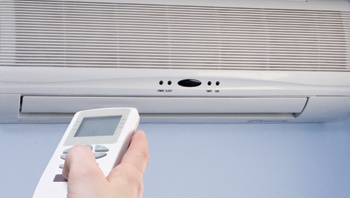Cooling a home on hot, humid days can be energy-intensive—in fact, cooling generally becomes the largest energy expense homeowners face during the summer. A room air conditioner may seem like an easy-to-install, low-cost way to add comfort, but it could waste energy and money.
A room air conditioner is basically a self-contained box designed to be mounted in a window, through a wall, or as a console. Costing between $100 and $1,000, they can be purchased at home improvement centers, big box retailers—even yard sales and flea markets. They tend to last a long time with minimal maintenance, so selecting the right unit is important.
Room air conditioners rated by Energy Star, the federal energy-efficiency program, are at least 10 percent more efficient than the federal standard. The energy-efficiency ratio (EER) measures each unit’s efficiency. The higher the EER rating, the more efficient the air conditioner will be. National appliance standards require room air conditioners built after January 1, 1990, to have a minimum EER of 8.0.
Energy Star-qualified units have advanced compressors that use less energy and run more quietly. However, they do cost slightly more.
An average consumer in a hot and humid state such as Texas could save up to 300 kilowatt-hours per year with an Energy Star-rated room unit versus a less efficient one.
Consumers should look for models with timers and programmable thermostats that allow users to cool spaces according to their preferences. For example, a homeowner can program the air conditioner to turn on 20 minutes before bedtime to make the bedroom comfortable.
Installing a room air conditioner is typically an easy job. Most units fit in a window. Large-capacity units often require a dedicated electrical circuit or may have specific wiring and breaker requirements. These units may need to be installed by a professional. Improper installation can negate the savings offered by even the most efficient of units.
Here’s a tip: Put window units in an east- or north-facing window out of the direct sun. It’s even better if the unit is shaded by a tree or awning. Also, make sure the external surface is not blocked by shrubbery. And, make sure the unit is level so its drainage system operates properly.
Room air conditioners come in a variety of sizes, and buying the right one is important. A unit that is too large will cool the room too quickly to properly remove all of the humidity, leaving the room feeling cool, but also wet and clammy. Buy the unit from a knowledgeable retailer who will help you select the right size for your room.
Consumers replacing an existing unit with a more efficient unit should not throw the old unit away. Air conditioners contain refrigerant that should be removed by a trained technician before the unit is recycled or discarded. Contact a local solid waste organization for information on how to properly dispose of old air conditioners.
Air conditioning will impact your monthly electric bill—your purchasing decisions, climate and length of use determine how much of an impact there will be. Making smart energy choices will leave you happier, cooler and with a couple of extra bucks in your pocket.

